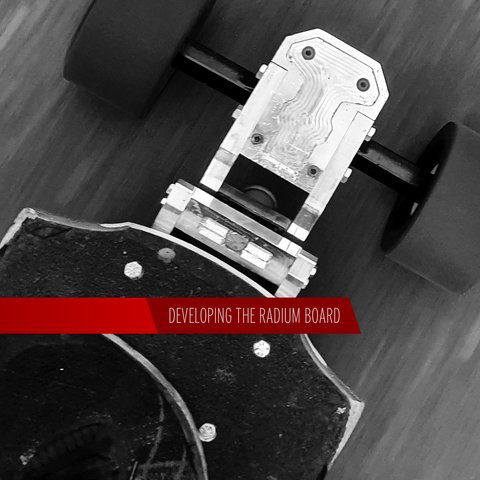Building an electric skateboard with a rigid deck and enclosure that still provides a smooth ride can be tackled in many ways. For us there were two really important defining constraints.
There are quite a few designs available that soften the ride by emulating cars with a full suspension system. Using control arms with ball joints, steering linkages, and a variety of mechanisms with lots of moving parts, these are everything we are against – complicated, heavy, fragile, high maintenance, and non-skateboard-like handling.
The Initial Concept
We came up with the idea to make the ends of the deck where the trucks mount into a separate component to the rest of the board. Able to swing up and down, like the rear suspension of a motorbike. This allowed us to consider the enclosure and deck in different ways.
We wanted a hinge point, mounted as far from the trucks as possible in order to keep the trucks somewhat level when hitting bumps. Otherwise this could potentially cause instability - when hitting a bump the tip of the deck would angle up, increasing the truck base plate angle which provides more steering, but less stability.
One of the biggest issues with making a compact and simple suspension system is the shock absorber. It's very difficult to find ones which are small and light enough for this application, with mountain bike shocks being the most common, and scooter ones only slightly smaller, less common, and frankly still too large. Spending the money and time required to develop a custom tiny shock absorber was not a path we wanted to go down. We believed it would still be too large to mount perpendicular to the swing arm in order to resist the arm movement.
Unless a cantilever linkage system was created, directing the force towards the enclosure and allowing the shock absorber to be mounted horizontally…
V1 Prototype
And so we came up with a design to test the concept with mostly guesstimated geometry. A basic prototype was machined on our Tormach 1100M CNC milling machine. For this test we used skateboard bushings as springs, with the ability to adjust the spring rate just by using different shape and hardness bushings.



Unfortunately it failed miserably. The first step on the “deck” (a plank of wood) sagged to the ground immediately with not even half the amount of an average person's body weight. The bushings didn't move so much as all the components around them just bent and distorted. But it was a start.
From this concept we learned a lot. Firstly, cantilever systems put a lot of force through components, and are too complicated for what we wanted to achieve, breaking our first defining rule.
The most important thing we learned here was – it was OK to just use skateboard bushings instead of expensive and heavy shock absorbers. They are light weight, readily available in all different shapes and sizes, simple, cheap, and super compact.
V2 Prototype
With lessons learned from the first prototype, we wanted to take advantage of skateboard bushings as shock absorbers. The solution we landed on was much more simple and robust.


It seemed to work on the plank, so we took the next step and acquired a second hand Landyachtz deck, chopping off the bits off we didn't need.



Test Riding
This thing was so much more awesome than we were expecting. A relatively dodgy concept prototype assembled with scrap parts and a hammer, but with such a smooth ride it was almost a daily for over a year!


For some reason the board just handled better than anything we'd ridden before.
The added shock absorption kept the deck always pressed against our feet and the way it carved was extremely satisfying once the right bushing combo was found. The suspension bushings actually affected how well it carved.
The most important finding of this test – the suspension system did not take away the experience of riding a “skateboard” and turn it into something different. It still handled just like a skateboard.
The Problem and the Solution
This design has one major issue – mounting it takes up a large amount of space on the deck where batteries and motor controller would normally be sitting. So to have a shock absorption system like this would mean we’d be restricted to a much smaller battery, or build a bigger board.
But compromises suck and the eskate industry is already full of them. We thought hard and came up with a new way of building an electric skateboard. Mounting a shock absorption system directly to the ends of the enclosure as opposed to the deck makes the enclosure the structural element carrying all of the weight. A lighter deck would sit on top and the battery size would not be compromised. The deck could easily be removed for internal access while still on all four wheels.
The result was a prototype "shock mount", a compact and simple way of adding shock absorption to a rigid structural enclosure and able to fit a large battery with an overall slimmer form factor.
NEXT UPDATE – Making the Enclosure and Deck Molds


